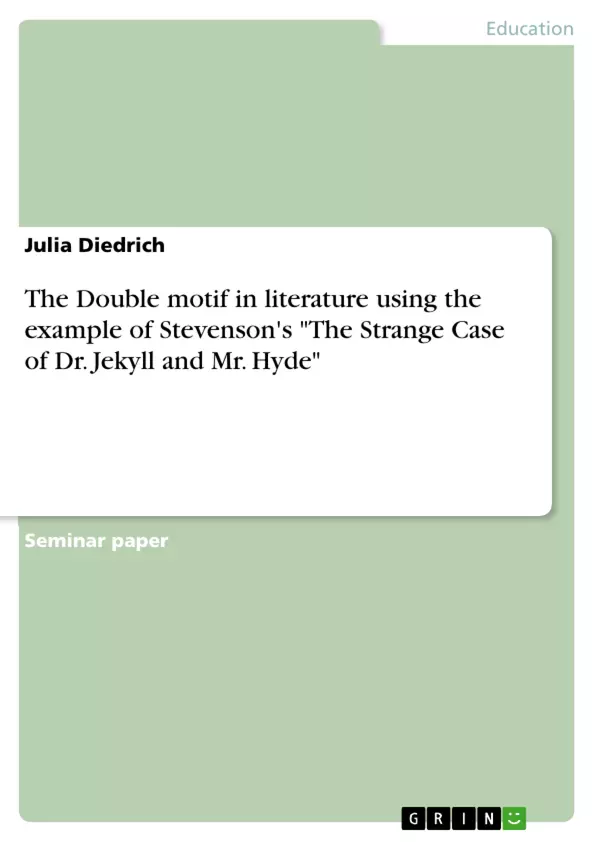Since the early beginning of literature the double motif has served in its different models to trace the features of the ego, individuality and perception. The double plays an important role in literature: it portays confusion and transformation, reflects inner desires and spreads anxiety. But the phenomenon is not just an invention of literature. Again and again people claim to see oneself like some famous persons such as Catharine the Great and Johann Wolfgang von Goethe.
This term paper will analyze the Double-motif in Robert Louis Stevenson’s novel The Strange Case of Dr. Jekyll and Mr. Hyde with regard to psychoanalysis. While citing secondary literature it became obvious that a good portion of these examinations use psychological criteria which offer a wider range of insight into the oddly logic of Stevenson’s text which he to no purpose named The Strange Case.
Three texts from Freud lend themselves to work with the novel: “Die ‘kulturelle’ Sexualmoral und die moderne Nervosität” (1908), “Das Unheimliche” (1919) and “Das Unbehagen in der Kultur” (1930). In “Das Unheimliche” Freud deals with the background of the double motif. He interprets the phenomenon from its probable beginning in mythology till the masterly usage of it in E.T.A Hoffmann’s “Sandman”.
In section two of this term paper I will give an overview of the double motif in literature. For this, I will explain the development of the term and its psychological implications. The third section will constitute the main part of the paper: I will first discuss two moments which can be interpreted with the help of psychology and then I will try to apply Freud’s theorems to the primary source which is full of repressed drives and desires.
Table of Contents
- Introduction
- The Double motif
- The Double motif in The Strange Case of Dr. Jekyll and Mr. Hyde
- The puzzling description of Dr. Jekyll's drives
- The realization of Jekyll's drives
- Psychological approaches to The Strange Case
- Summary
Objectives and Key Themes
This term paper aims to analyze the Double motif in Robert Louis Stevenson's novel *The Strange Case of Dr. Jekyll and Mr. Hyde* with regard to psychoanalysis. It explores the psychological implications of the Double motif in literature, specifically focusing on its evolution and application in Stevenson's work. The main themes of the paper include: * The psychological implications of the Double motif in literature * The development of the Double motif throughout history * The application of Freudian psychoanalysis to *The Strange Case of Dr. Jekyll and Mr. Hyde* * The role of repressed drives and desires in shaping the characters' actions * The relationship between the ego and the alter egoChapter Summaries
The first chapter introduces the Double motif as a recurring theme in literature, highlighting its ability to depict confusion, transformation, inner desires, and anxiety. It explores the historical development of the concept from ancient mythology to modern literature, emphasizing the importance of psychoanalysis in understanding the motif. The second chapter delves into the psychological implications of the Double motif. It analyzes the evolution of the Double concept in three distinct levels, ranging from visually identical twins in comedies of mistaken identities to the manifestation of repressed desires in a single individual, as seen in Stevenson's *Jekyll and Hyde*. The third chapter focuses on the analysis of *The Strange Case of Dr. Jekyll and Mr. Hyde*, examining two key moments within the narrative that can be interpreted using psychological lenses. The chapter aims to apply Freudian theories of the unconscious, repressed drives, and desires to the novel, exploring the complex motivations and struggles of Dr. Jekyll and his alter ego, Mr. Hyde.Keywords
The primary keywords and focus topics of this paper revolve around the Doppelganger motif, its evolution, and its manifestation in Robert Louis Stevenson's *The Strange Case of Dr. Jekyll and Mr. Hyde*. Key terms include: Double motif, Doppelganger, psychoanalysis, Freud, repressed drives, desires, ego, alter ego, transformation, identity, and split personality.- Quote paper
- Julia Diedrich (Author), 2009, The Double motif in literature using the example of Stevenson's "The Strange Case of Dr. Jekyll and Mr. Hyde", Munich, GRIN Verlag, https://www.grin.com/document/139385



